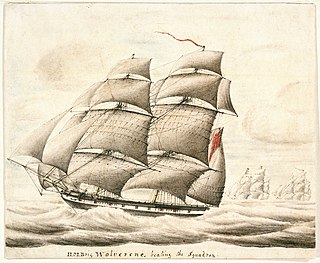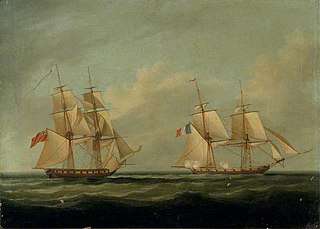
HMS Sirius was a 36-gun fifth-rate frigate of the Royal Navy. Between 1797 and 1805, the Sirius was engaged in maintaining the blockade of Napoleonic Europe. She was lost in 1810 when her crew scuttled her after she grounded during the Battle of Grand Port.
Heureux was a 22-gun French privateer brig that the British captured in 1800. She served with the Royal Navy as the 22-gun post ship HMS Heureux. She captured numerous French and Spanish privateers and merchant vessels in the Caribbean Sea before she was lost at sea in 1806. Her fate remains a mystery to this day.

HMS Reindeer was a Royal Navy 18-gun Cruizer-class brig-sloop of the Royal Navy, built by Samuel & Daniel Brent at Rotherhithe and was launched in 1804. She was built of fir, which made for more rapid construction at the expense of durability. Reindeer fought in the Napoleonic Wars before succumbing in 1814 to the guns of USS Wasp during the War of 1812.

Franchise was launched in 1798 as a 40-gun Coquille-class frigate of the French Navy. The British captured her in 1803 and took her into the Royal Navy under her existing name. In the war on commerce during the Napoleonic Wars she was more protector than prize-taker, capturing many small privateers but few commercial prizes. She was also at the battle of Copenhagen. She was broken up in 1815.

HMS Kingfisher was a Royal Navy 18-gun ship sloop, built by John King and launched in 1804 at Dover. She served during the Napoleonic Wars, first in the Caribbean and then in the Mediterranean before being broken up in 1816.

HMS Wolverine was a Royal Navy 18-gun Cruizer-class brig-sloop, launched in 1805 at Topsham, near Exeter. Early in her career she was involved in two fratricidal incidents, one involving a British frigate and then a newsworthy case in which she helped capture a British slave ship. She later captured a small naval vessel and several privateers, and took part in the invasion of Martinique, and during the War of 1812, in the attack on Baltimore. Wolverine was decommissioned in August or September 1815 and was sold on 15 February 1816.

HMS Tartar was a 32-gun fifth-rate Narcissus-class frigate of the Royal Navy, built at Frindsbury and launched in 1801. She captured privateers on the Jamaica station and fought in the Gunboat War and elsewhere in the Baltic Sea before being lost to grounding off Estonia in 1811.

HMS Curieux was a French corvette launched in September 1800 at Saint-Malo to a design by François Pestel, and carrying sixteen 6-pounder guns. She was commissioned under Capitaine de frégate Joseph-Marie-Emmanuel Cordier. The British captured her in 1804 in a cutting-out action at Martinique. In her five-year British career Curieux captured several French privateers and engaged in two notable single-ship actions, also against privateers. In the first she captured Dame Ernouf; in the second, she took heavy casualties in an indecisive action with Revanche. In 1809 Curieux hit a rock; all her crew were saved but they had to set fire to her to prevent her recapture.
HMS Pike was a Royal Navy Ballahoo-class schooner of four 12-pounder carronades and a crew of 20. The prime contractor for the vessel was Goodrich & Co., in Bermuda, and she was launched in 1804. She captured one 10-gun enemy vessel before being herself captured, and recaptured.

HMS Dispatch was a Royal Navy Cruizer-class brig-sloop built by Richard Symons & Co. at Falmouth and launched in 1804. Dispatch was instrumental in the capture of a 40-gun French frigate and was active at the Battle of Copenhagen in 1807. She also sailed on the Jamaica station. She was broken up relatively early, in 1811.
HMS Elk was a Cruizer-class brig-sloop, built of pine, and launched in 1804. She served on the Jamaica station where she captured a number of privateers. She was broken up in 1812.

HMS Superieure was the French privateer Supérieure, which was built in 1801 in Baltimore, Maryland, and which the British captured in 1803 in the West Indies, and took into the Royal Navy. She spent most of her career on the Jamaica and Leeward Islands stations, where she captured numerous privateers. She participated in several notable single-ship actions, including one in which she harassed a frigate, and two campaigns that would, in 1847, earn her surviving crew members the Naval General Service Medal (NGSM). She was laid-up in Britain in 1810 and sold in 1814.

HMS Childers was a brig-sloop of the British Royal Navy, initially armed with 10 carriage guns which were later increased to 14 guns. The first brig-sloop to be built for the Navy, she was ordered from a commercial builder during the early years of the American War of Independence, and went on to support operations in the English Channel and the Caribbean. Laid up for a time after the end of the American War of Independence, she returned to service shortly before the outbreak of the French Revolutionary Wars. She had an active career in both the French Revolutionary and Napoleonic Wars, capturing numerous French privateers and during the Gunboat War participated in a noteworthy single-ship action. The navy withdrew her from service at the beginning of 1811, at which time she was broken up.
HMS Renard was the French privateer Renard, launched in 1797, that Cerberus captured in the Channel that same year. The Royal Navy took her into service under her existing name and she participated in some notable engagements on the Jamaica station before the Navy sold her in 1809.
HMS Diligent was the French naval brig Diligent, launched in 1800, that HMS Renard captured in 1806. The Royal Navy took her into service under her existing name, which it later changed, first to Prudente, and then to Wolf. During her two years of active duty with the Royal Navy she captured two small privateers. Wolf was laid up in 1808 and sold in 1811.
The French corvette Bacchante was launched in 1795 as the second of the four-vessel Serpente class of corvettes. She served for almost two years as a privateer, before returning to the service of the French Navy. After HMS Endymion captured her in 1803, the Royal Navy took her in under her existing name as a 20-gun post ship. Bacchante served in the West Indies, where she captured several armed Spanish and French vessels before the Navy sold her in 1809.

HMS Echo, launched in 1797 at Dover, was a sloop-of-war in the Royal Navy. She served on the Jamaica station between 1799 and 1806, and there captured a small number of privateers. The Navy sold her in 1809 and she became a whaler. She made four complete whale-hunting voyages but was wrecked in the Coral Sea in April 1820 during her fifth whaling voyage.
HMS Morne Fortunee was the French privateer Regulus that British Royal Navy captured in 1804. In 1806 the Royal Navy commissioned her. She captured some small privateers and took part in a number of other engagements. She foundered in 1809.
HMS Firefly was the Spanish schooner Antelope, which the British Royal Navy captured in February 1808 and purchased. She was renamed Antelope in 1812, or possibly in 1809. She was broken up in 1814.
HMS Gipsy was purchased at Jamaica in December 1804. She was probably the Dutch schooner Antilope, and the government of Barbados had previously hired her. She was sold in 1808.










